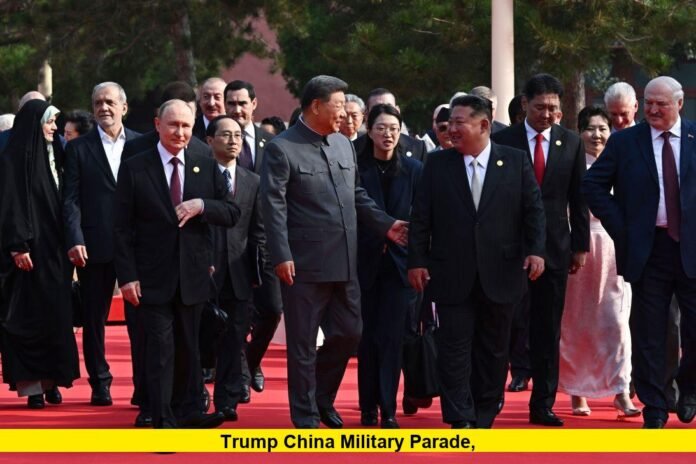Trump China military parade reactions dominated headlines today as former President Donald Trump sharply criticized China’s massive display of military power in Beijing. The parade, held at Tiananmen Square, marked the 80th anniversary of Japan’s surrender in World War II and showcased some of the world’s most advanced weaponry.
China’s Parade in Beijing
Today, President Xi Jinping presided over one of the largest military parades in China’s history. The event featured thousands of troops, cutting-edge stealth aircraft, intercontinental ballistic missiles, hypersonic weapons, and AI-driven defense systems.
Xi delivered a forceful speech, declaring that the world faces a choice between “peace or war” and that China’s rise is “unstoppable.” The ceremony also included symbolic gestures such as the release of white doves, while the massive display underscored China’s ambition to assert global leadership.
Standing beside Xi were Russian President Vladimir Putin and North Korean leader Kim Jong Un. Their presence highlighted a growing alignment among nations often seen in opposition to the United States and its allies.
Trump’s Swift Response
Not long after the event, Donald Trump took to his social media platform to deliver a pointed reaction. In a characteristically sharp tone, Trump sarcastically extended “warm regards” to Xi, Putin, and Kim, accusing them of plotting against the United States.
He also criticized China’s portrayal of history, noting how American contributions in World War II were minimized in the commemoration. Trump insisted that the U.S. is not intimidated by China’s military demonstrations and emphasized America’s enduring global power.
Symbolism Behind the Parade
This parade was about far more than showcasing hardware. It was a political and diplomatic signal. By hosting both Putin and Kim on the reviewing stand, Xi underlined China’s role at the center of a bloc challenging Western influence.
For China, the parade was an opportunity to:
- Highlight technological advancements in its military.
- Reaffirm ties with Russia and North Korea.
- Project strength on a symbolic date tied to victory in WWII.
- Deliver a message of defiance to Western powers, particularly the United States.
Comparing Parade and Trump’s Reaction
| Element | Beijing’s Parade | Trump’s Response |
|---|---|---|
| Purpose | 80th WWII anniversary, show of force | Criticism and sarcasm online |
| Leaders Present | Xi, Putin, Kim | None—commented via social media |
| Military Display | Missiles, stealth jets, AI systems, naval power | Emphasized U.S. resilience, mocked rivals |
| Main Message | China’s rise, “peace or war” theme | Warning of adversaries conspiring |
Geopolitical Impact
The Trump China military parade debate underscores rising global tensions. For Washington, the images of Xi, Putin, and Kim standing together represent a challenge to American influence and a reminder of the shifting balance of power.
Meanwhile, Trump’s vocal reaction reflects how U.S. politics continue to engage with these developments. His remarks serve as both criticism of China’s ambitions and a warning about the risks of closer ties among U.S. rivals.
Closing Thoughts
Today’s military parade in Beijing was more than a ceremonial event—it was a statement of intent. Trump’s immediate response shows how closely the U.S. watches these displays and how symbolic they are in shaping global narratives.
What’s your take on the Trump China military parade? Share your thoughts and join the discussion below.
